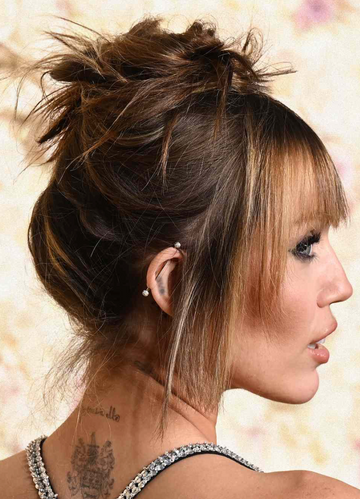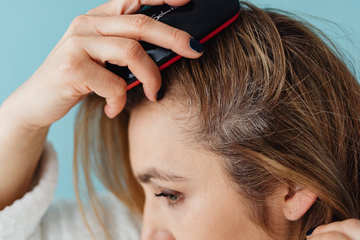You’ve tried everything topical. Time to think deeper.
One minute it’s for brain fog. Next, your heart health. Then your skin. Now your hair? If omega-3s had a PR team, they deserve a raise—because fish oil is officially in its beauty era.
Let’s be real: for years, omega-3 supplements were tucked in the back of your parents’ medicine cabinet—smelling weird, sounding boring, and branded as something for “cholesterol support.” Fast-forward to 2025, and suddenly, omega-3s are showing up in your scalp serum, your influencer’s smoothie, and every beauty editor’s supplement stack.
But is it hype… or is your hair craving omega-3?
Short answer: yes. Long answer? Omega-3 for hair isn’t just another trendy nutrient. These good fats (specifically DHA and EPA) are essential for cell function and inflammation regulation—aka the two things your scalp needs to support stronger strands and a healthier growth cycle. Translation: less shedding, more shine, and strands that don’t tap out mid-style.
And no, this doesn’t mean downing spoonfuls of fish oil like it’s 2010. There are way better ways to get the goods, and we’re diving into all of them.
So if your hair’s been looking a little sad lately, this might be the missing piece—and it’s a whole lot easier to fix than you think.
What is omega-3, really? (and why should haircare girlies care?)
Okay, let’s break this down without turning it into biology class.
Omega-3s are a type of essential fatty acid—basically, the “good fats” your body can’t make on its own, but desperately needs. You’ve probably heard about them in the context of brain health, heart function, and anti-inflammatory diets. But zoom in a little closer, and you’ll find that they’re also doing major behind-the-scenes work for your skin, scalp, and hair.
There are three main types of omega-3s.
– ALA (alpha-linolenic acid) – Found in plant oils like flaxseed, chia seeds, and walnuts. ALA is the entry-level omega—it needs to be converted into the other two to be fully effective, and not all of it makes the cut.
– EPA (eicosapentaenoic acid) – Typically found in fatty fish (like salmon, mackerel, sardines). EPA helps reduce inflammation, which is low-key huge for calming scalp irritation and supporting a healthy hair follicle environment.
– DHA (docosahexaenoic acid) – Also found in oily fish and algae. DHA is the MVP when it comes to cell membrane health, including the ones in your scalp and hair follicles. Stronger membranes = better moisture retention and protection for your strands.
Think of it like this.
Omega-3s help build the literal foundation of your hair health—from the follicle up. They're not styling products or miracle serums. They’re what makes those products actually work better, because they’re feeding your hair at the root (and under the root, to be exact).
And before you eye-roll and say, “This sounds like a wellness influencer trying to sell me supplements,” let’s just say this: real studies back this up. We're talking increased hair thickness, reduced shedding, improved shine, and scalp health benefits—all linked to omega-3s (and we’ll break that down in a sec).
Bottom line: if you want your hair to grow stronger, shinier, and actually stay attached to your head longer, your omega-3 intake deserves your attention.
Omega-3 for hair—what the science says
Okay, does omega-3 actually do anything for your hair, or is it just another wellness buzzword slapped on a shampoo bottle?
Turns out, there's legit research that says: yes, omega-3s can help support your hair health. Not just in a “might maybe possibly someday” way—but in real, measurable ways like less shedding, improved thickness, and a healthier, calmer scalp.
Let’s look at the receipts.
The 2015 study that changed the game
A study published in the Journal of Cosmetic Dermatology followed 120 women with thinning hair over six months. Half took supplements rich in omega-3 and omega-6 fatty acids, while the others didn’t. The result? The omega group reported:
– Less hair shedding
– Noticeably thicker strands
– A healthier scalp
– And a whopping 89% said their hair felt improved overall
That’s not just a placebo effect either—those are stats worth paying attention to.
More good news for follicles
A 2018 animal study (rat whiskers, yes really) found that fish oil, rich in EPA and DHA, helped trigger hair follicles into their active growth phase. It also sped up hair fiber elongation and increased follicle cell activity. Translation: Omega-3 didn’t just support growth—it helped kickstart it.
Omega-3 = anti-inflammatory powerhouse
Chronic scalp inflammation can quietly sabotage your hair, leading to breakage, thinning, and even slowed growth. Omega-3s (especially EPA) help fight inflammation at the cellular level, giving your scalp the calming, nourishing environment it needs to support consistent growth and strength.
Moisture retention & shine
DHA is particularly good at helping cells hold on to hydration. This means less brittle hair, more bounce, and that natural shine we all pretend comes from our hair oil but actually starts at a cellular level.
Let’s be clear: Omega-3 isn’t a miracle growth pill. It’s not going to transform your hair overnight. But what it can do is support your body in creating the healthiest possible conditions for growth, strength, and retention. And when you pair it with the rest of a smart routine? It hits.
So, what are the signs your hair might actually need omega-3 in the first place? Let's break that down.
Signs your hair might be craving omega-3
Not every bad hair day is a dry shampoo issue. If your strands feel off, and no product is really helping, it could be something deeper. Like, nutritional level deeper. And yep, low omega-3 might be the quiet villain behind the chaos.
Here’s what your hair (and scalp) might be trying to tell you.
You’re shedding more than usual
If your hairbrush is suddenly looking like a shag carpet, your omega intake might be off. Research shows omega-3s help keep hair in the anagen (growth) phase longer. Less omega = more shedding. It’s not instant hair loss, but it’s enough to notice when you're styling or washing.
Your scalp feels dry, tight, or flaky
Omega-3s support scalp hydration and barrier function. Without enough, your scalp can go full Sahara—dry, itchy, flaky, and reactive. You may even notice more dandruff or irritation after using styling products or dry shampoo.
Your shine has disappeared
Even healthy hair can lose its shine if your cells aren’t locking in moisture. Since omega-3s strengthen cell membranes, they help your strands retain hydration—aka that glow you can’t get from a serum alone.
You’re breaking or snapping mid-shaft
When your strands are dry from the inside out, they lose elasticity. And when that happens, hair breaks halfway down, not just at the ends. If your ends are intact but you're still dealing with damage? That’s your cue.
Your hair just feels… dull
You know that soft, healthy weight hair has when it’s thriving? Gone. And in its place: fluff, static, or a flat, lifeless vibe that doesn’t even respond to your usual go-to products. Low omega levels can mess with your hair’s texture in subtle but annoying ways.
Of course, none of these signs prove a deficiency—but if you’re nodding along to two or more? It might be time to look at what’s on your plate.
Next on the list? How omega-3 helps hair grow (and what it doesn’t do, because no false promises here).
Omega-3 hair growth benefits (and what it doesn’t do)
If you’ve been burned by hair vitamins that promised Rapunzel in 30 days, you’re not alone. So let’s get this out of the way early: Omega-3 isn’t a magic pill for instant inches.
But what is it? A major player in creating the conditions your hair needs to grow, thrive, and stay strong over time. It’s giving consistency, not overnight miracles—and that’s honestly what most of our hair needs anyway.
Here’s what omega-3 for hair can actually do.
Support hair growth from the scalp up
Remember, omega-3s are anti-inflammatory powerhouses. They help create a calm, balanced scalp environment where follicles can do their thing without irritation, buildup, or stress-induced disruption. That means healthier, longer-lasting growth cycles and less shedding.
Strengthen your strands
Omega-3s help lock moisture into the hair shaft from the inside out—strengthening structure, reducing brittleness, and giving your strands more elasticity. More bounce, less breakage.
Improve natural oil production
If your scalp’s been flaky, tight, or just blah, omega-3s may help balance sebum production. That means better hydration levels and a natural shine that actually sticks around past day two.
Boost thickness and density
One of the biggest reported benefits in clinical studies? Hair feels fuller and thicker. Omega-3s help strengthen the actual follicle structure, which can improve the density of hair over time—even if you’re not growing more, it feels like you are.
Reduce stress-related fallout
Chronic stress can tank your hair health, causing everything from telogen effluvium (aka sudden shedding) to dullness and dryness. Omega-3s have been shown to support mood and stress regulation, which can have a subtle but powerful impact on your hair.
Now for the truth bomb.
Omega-3s won’t cure bald spots. They won’t regrow lost hair from permanent damage. And they’re not a substitute for medical intervention if you're dealing with hormonal or genetic hair loss. What they can do is support the overall structure, hydration, and function of your hair system—aka the best kind of long game.
Now, how do you actually get more omega-3s into your hair care routine, without choking down fish oil every morning? That’s coming next. Let’s make it realistic.
How to add omega-3 into your hair care routine (realistically)
You don’t need to start blending anchovies into your green juice. There are easy, non-gross ways to get more omega-3 for hair into your routine—and the best part? You can do most of it without changing your entire life or dropping $60 on supplements.
Here’s how to start, your way.
1. Eat more omega-rich whole foods
This is the simplest, most natural place to begin. Some of the best omega-3 sources for hair are already on your grocery store shelves—and probably on your Pinterest meal board, too.
– Fatty fish (salmon, mackerel, sardines, tuna)
– Flaxseeds and chia seeds
– Walnuts
– Seaweed and algae-based foods
– Omega-3-fortified eggs or plant milks
Aim for two to three servings of omega-3-rich foods per week. Bonus: you’re also supporting your skin, mood, and overall health while you’re at it.
2. Consider a supplement—but read the label
If whole foods aren’t your thing, omega-3 supplements can help fill in the gaps. Look for one with both EPA and DHA, ideally sourced from fish oil or algae oil if you’re plant-based.
Check that it contains at least 250–500 mg of combined EPA/DHA per serving—anything less might not move the needle. And avoid anything that smells like low tide. High-quality brands shouldn’t leave a lingering aftertaste or cause indigestion.
3. Try topical blends (just don’t expect miracles)
There are a few scalp oils and hair products formulated with omega-rich ingredients like flaxseed, sea buckthorn, or algae. These can add surface-level nourishment and support hydration, but they won’t replace internal sources. Use them as a nice bonus, NOT your main plan.
4. Be consistent, not extreme
Adding omega-3 into your routine isn’t about overhauling your entire diet or popping five pills a day. Small, regular improvements are where the real results come from. A few tweaks to your grocery list or adding a quality supplement to your morning routine can go a long way.
And remember: your hair grows in cycles. Most people won’t notice major changes overnight. But with consistent omega-3 intake, the benefits start stacking up—stronger strands, healthier scalp, and that shine-from-within glow we all chase in the beauty aisle.
Is omega-3 your hair’s new secret weapon?
If your hair is dry, shedding, or just not giving what it used to, your first step doesn’t have to be a new serum or another deep conditioner. Sometimes, the answer is internal. And omega-3 for hair might be exactly what your strands have been missing.
It’s not a magic fix or a shortcut to inches overnight. But it is a science-backed way to support scalp health, reduce inflammation, and help your hair grow stronger, thicker, and shinier—naturally and sustainably.
Great hair doesn’t just happen—it grows from the inside out. And when your routine supports your scalp on a cellular level, everything from shine to strength starts to shift.
This is your sign to stop skipping the omegas.





